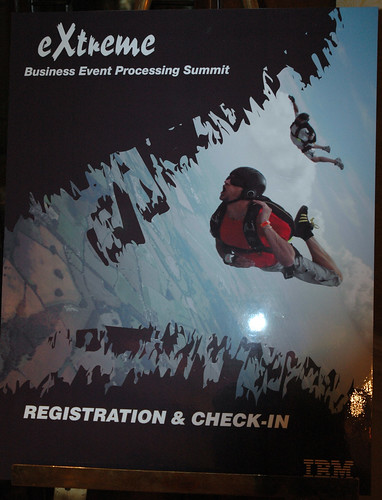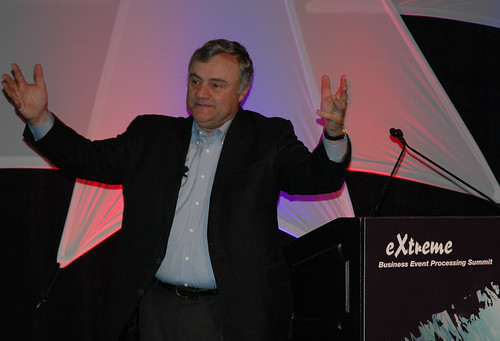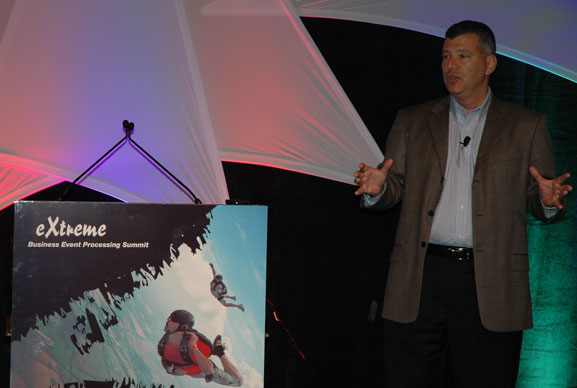I'm at the Taj Hotel, attending IBM's eXtreme Business Event Processing Summit, looking to live blog the action as IBM's Software Group senior VP Steve Mills takes the stage to make what's expected to be some big announcements. I'll be updating this blog with text, photos, and eventually video (once we get it produced). First up at the podium was IBM SOA & WebSphere VP Sandy Carter (photo below), who set the stage by defining the term "event," setting the tone for IBM's road map to make business

I'm at the Taj Hotel, attending IBM's eXtreme Business Event Processing Summit, looking to live blog the action as IBM's Software Group senior VP Steve Mills takes the stage to make what's expected to be some big announcements. I'll be updating this blog with text, photos, and eventually video (once we get it produced). First up at the podium was IBM SOA & WebSphere VP Sandy Carter (photo below), who set the stage by defining the term "event," setting the tone for IBM's road map to make businesses more agile in the way they respond to such events.To set the tone for this blog post, here's the nut of the press release:
With today's announcement, IBM completes the foundation for the industry's most comprehensive event processing portfolio. The technology can automatically track, analyze, and respond to changing business conditions -- whether the events that trigger them are planned or unplanned. Unlike other vendors, IBM business event processing software incorporates both business and IT events into a single, unified business view that taps the greatest number of information resources in the industry.
Update: We recorded a video from the event and are posting both the video itself as well as the audio (from the video). Here's the video:
You can download the audio or use the player below to play it back directly from this blog post:
Shortly after Steve Mills takes the stage, he tries to give everyone in the room a sense of the number of business events that occur every day.
72 quadrillion business events
4 triillion RFID events emitted each day
190 billion e-mails sent daily
So far the best quote from Mills (in referring to the ability to track business events in real time):
The U.S. military wants to know where all their tanks are all the time... you'd think it's hard not to lose a tank.
Pictured below, the poster for the event:

It's an important announcement, judging by the way the room is set up. IBM didn't spare any expense. Pictured below: Sound check before things kicked off:

Pictured below, Sandy Carter opened things up, making the connection between the "eXtreme" branding of the announcement and the event with her former "profession" as a motorcycle racer. No helmet or gear this time, though:

Here, Steve Mills telling the attendees (a mixture of press, analysts, customers, and, of course, whenever Mills is involved, a bunch of IBMers and PR people) about why IBM, in the context of business event processing, offers the lowest latency of any competitor:

Part of Mills' message today (Download Steve Mills' Slide Deck) was how, as result of a bunch of acquisitions, IBM has the broadest portfolio of offerings that can be integrated at the customer's option for responding in "extreme fashion" (aka real time) to business events (e.g.: a tank disappearing from the battlefield). These acquisitions are listed below, and linked to the acquisition news:
Mills referred specifically to the solid acquisition as one that delivers on the promise of extreme business event processing. According to our coverage of the Solid Information Technology acquisition when it happened:
Solid specializes in developing databases that are stored in a computer's high-speed random access memory (RAM), bypassing the hard drive. The result is a system that can deliver data to applications virtually in real time, according to Solid....Solid's in-memory databases work with applications built for the open, MySQL environment and with commercial applications.
Comparing IBM to other solution providers in the market, Mills claimed that no one has the breadth that IBM has. "It's not that we're the only [offering in the market]", said Mills. Mills claimed that no other vendor offers the combination of "core processing capability, high performance transaction and messsaging infrastructure, significant database capacities and unique abilities to deal with real world physical things."
Focusing on one of the business problems whereby events can be connected to the bottom line, Mills claimed that no other company is prepared to deal real world equipment and physical assets (trains, planes, buses, energy plants) the way IBM is. "[All these physical assets] need to be managed. We have the ability to instrument them and monitor them." Mills talked about how the management of these assets becomes more critical in this world as the replacement costs escalate and the focus shifts to maintenance. So, the implication is that through extreme real time time business event processing, the life expectancy of certain physical assets can be extended, thereby off-putting replacement costs; something that would accrue to the bottom line.
Although IBM offers such solutions, Mills warned:
Don't confuse this with generic SOA, data warehouse, or data analytics. The stresses [of real-time business event processing] are orders of magnitude greater than the every day stresses of things like classical data warehousing....no one has more customers, doing more transactions... no one has lower latency....we are the unquestioned market leader in terms of the clients and the capacity of the technology.
During the Q&A after Mills' presentation, he was directly asked by one of the attendees about how he could make the claim regarding low latency (what is being referred to as "ultra-low latency") and his answer was "benchmarks."
After Mills got off stage, IBM WebSphere general manager Tom Rosamilia gave specific examples of ultra-low latency. For example, the ability to reroute energy across the power grid based on the "business events" (e.g.: brownouts or blackouts) being monitored by the technology infrastructure.
Below, IBM's Tom Rosamilia discusses the specific announcements that IBM is making within the WebSphere portfolio of products (I will try to list those in a second... there's a lot of them but here's a downloadable version of his slide deck in PDF form):

The basic fundamentals of real-time business event processing, according to Rosamilia, are the following (stolen from one of his slides):
Increased Insight -- it's one thing to accumulate all the data, monitor all the events, but the key is get real insight into what's happening with your business as it happens.
Ultra Low Latancy -- clearly referring to the performance of the event processing system, but here, the question is how much time it takes for data to be converted into an event that is in turn recognized as being important enough to act on (based on business rules described by line of business managers.
Dependability - at scale, the system can't crash. As Rosamila later mentioned, this isn't about being able to handle "gusts of wind" but rather a "sustained wind."
Interconnectedness -- referring largely to the many adapters and means of connecting to existing external systems (eg: SAP), one of the keys says Rosamilia is to be able to assemble a business event processing infrastructure without having to necessarily start from scratch and to be able to rely on existing systems to easily plug into the event processing capability. One of today's announcements was a new "SupportPac" for users of IBM's CICS (pronounced "kicks") solutions. The SupportPac (available for free to existing CICS customers) will allow CICS systems to emit events to the WebSphere-based event processing system.
Scalability - needs no explanation, but through the event, various examples were given of the scale that IBM's solutions can operate at. For example, Rosamilia claimed that the newly announced WebSphere MQ Low Latency Messaging v2.1 can handle 40 million messages per second
Under the hood of an events business processing system, or in "the piping," as Rosamila put it, are certain systems (not surprisingly, all of which can be had from IBM). From one of the slides:
Message Queues: advanced delivery with integrity
ESBs: more volume and connections
Adapters: for heterogeneity
Transaction Servers for higher performance operations and managed flows
Application Servers for executing the biggest environements
Process Execution Engine for managing interlocking processes efficiently
Rosamilia gave some specific examples of where all these systems (including non-IBM ones) can tie together to deliver real business value. He spoke about the aircraft manufacturer Airbus and showed how its event processing capability around logistics for aircraft part delivery and assembly relies on RFID and a bunch of IBM event-processing solutions (e.g.: a couple of WebSphere servers) tied to an SAP inventory management system that spits events out to the event processing system.
One key, though, according to Rosamilia, is being able to correlate events to one another in real time, to spot potential relationships, and to make fast business decisions. The example he gave had to do with how a bank's business event processing system might correlate a password change, an address change, and a large withdrawal (all within seconds of each other) in a way that triggers a decision to shut the account down due to suspicion of malicious activity. Taken alone, each of the events is meaningless. Taken together over a very collapsed period of time, then something bad (e.g.: bank fraud) could be about to happen. Rosamilia emphasized the sort of scale, low-latency, and the ability for business managers to define what combination of events over a given time frame is enough to trigger a business decision.
Rosamilia finally got around to the specific announcements regarding IBM's portfolio of products. The list below details some of what was announced today:
WebSphere Business Events 6.2: Before the end of the year, IBM will add support for the zLinux (mainframe Linux) and Solaris operating systems to WebSphere Business Events 6 (formerly, the AppSoft solution). Also on tap for WebSphere Business Events 6.2 is full internationalized language support. The current version only supports core English. IBM WebSphere Extreme Scale 6.2: According to Rosamilia, one of the keys to success with business event processing is the support of non-technical line of business authors. "You don't want to have to code the application.... you want the business manager to be able to decide [on what business events to correlate and when to bubble that into the decision making process]. On top of that, you want to be able to process 1 million business events per second around the globe just as well as you can process 1 million business events on one system. Based on its own benchmarks, IBM believes this latest version is unmatched in scale by competitors as well as its predecessor "by orders of magnitude." Rosamilia called it "operating at the speed of business."
WebSphere Front Office for Financial Markets 3.0: Formerly, the Infodyne solution (one of IBM's acquisitions), not only have improvements been made on the low latency messaging front, customers now have access to more than 40+ market feeds, all of which can be sources of "business events" (and therefore, are candidates for business event processing).
WebSphere MQ Low Latency Messaging v2.1: Based on Infiniband, this solution is now capable of processing 40 million messages per second with a maximum 5 microsecond latency. IBM has added some new high availbility features as well as new APIs and Rosamilia says it performs at more the 6 times the performance of what the close competitor can do.
Free CICS SupportPac: CICS is almost 40 years old (actually, it's 39 1/2 right now). Today, IBM announcing a free "SupportPac" that's available to all of IBM's CICS customers that makes it so CICS can emit events that can be captured by Websphere Business Events.
WebSphere Business Monitor v6.1.2: This part of the portfolio that handles alerting and mobile access. Originally, IBM supported RIM's BlackBerrys (in terms of commonly used mobile platforms). Now, claims Rosamilia, the product is getting some new features, including support for the iPhone.
About the Author(s)
You May Also Like





